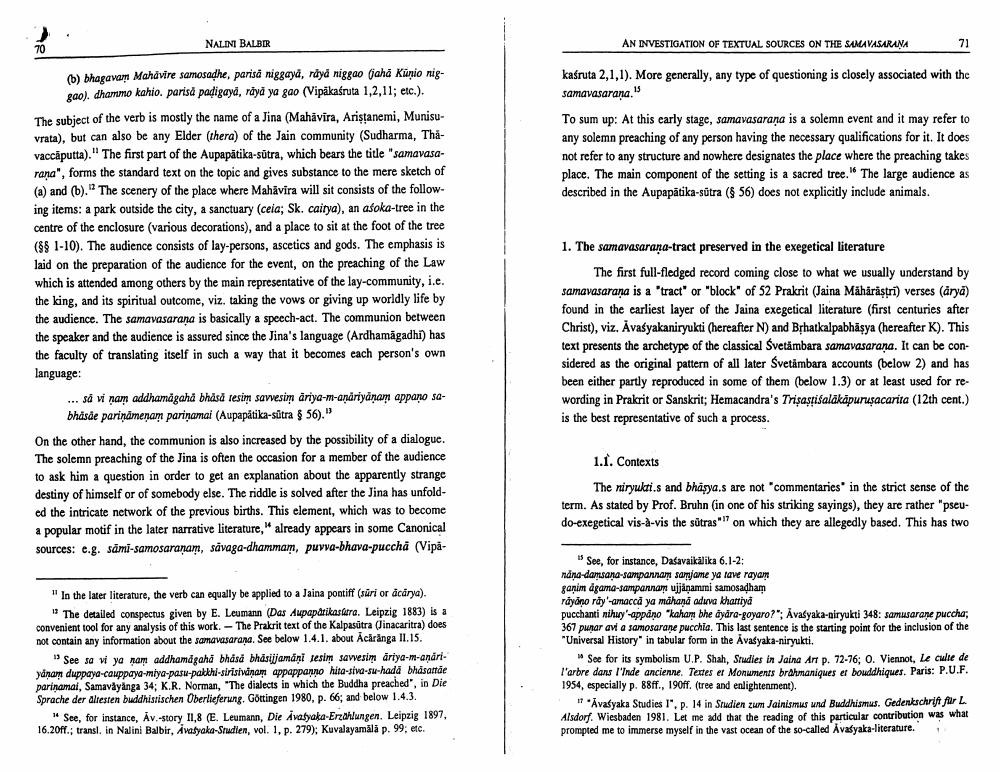Book Title: An Investigation Of Textual Sources On Samavasarana Author(s): Nalini Balbir Publisher: Nalini Balbir View full book textPage 3
________________ 7 70 NALINI BALBIR (b) bhagavam Mahavire samosaḍhe, parisä niggaya, raya niggao (jaha Kūnio niggao). dhammo kahio. parisă paḍigaya, raya ya gao (Vipäkaśruta 1,2,11; etc.). The subject of the verb is mostly the name of a Jina (Mahavira, Ariṣṭanemi, Munisuvrata), but can also be any Elder (thera) of the Jain community (Sudharma, Thavaccaputta)." The first part of the Aupapätika-sutra, which bears the title "samavasarana", forms the standard text on the topic and gives substance to the mere sketch of (a) and (b). The scenery of the place where Mahavira will sit consists of the following items: a park outside the city, a sanctuary (ceia; Sk. caitya), an aśoka-tree in the centre of the enclosure (various decorations), and a place to sit at the foot of the tree (§§ 1-10). The audience consists of lay-persons, ascetics and gods. The emphasis is laid on the preparation of the audience for the event, on the preaching of the Law which is attended among others by the main representative of the lay-community, i.e. the king, and its spiritual outcome, viz. taking the vows or giving up worldly life by the audience. The samavasarana is basically a speech-act. The communion between the speaker and the audience is assured since the Jina's language (Ardhamāgadhi) has the faculty of translating itself in such a way that it becomes each person's own language: ... så vi nam addhamägaha bhäsä tesim savvesim ariya-m-aṇāriyāṇam appano sabhäsäe pariņāmenam pariņamai (Aupapātika-sūtra § 56)." On the other hand, the communion is also increased by the possibility of a dialogue. The solemn preaching of the Jina is often the occasion for a member of the audience to ask him a question in order to get an explanation about the apparently strange destiny of himself or of somebody else. The riddle is solved after the Jina has unfolded the intricate network of the previous births. This element, which was to become a popular motif in the later narrative literature," already appears in some Canonical sources: e.g. sami-samosaraṇam, savaga-dhammam, puvva-bhava-puccha (Vipa "In the later literature, the verb can equally be applied to a Jaina pontiff (süri or ācārya). 13 The detailed conspectus given by E. Leumann (Das Aupaparikastra. Leipzig 1883) is a convenient tool for any analysis of this work. - The Prakrit text of the Kalpasütra (Jinacaritra) does not contain any information about the samavasarana. See below 1.4.1. about Acărănga II.15. See sa vi ya nam addhamagaha bhasa bhäsijjamani sesim savvesim äriya-m-anariyanam duppaya-cauppaya-miya-pasu-pakkhi-sirisiväṇam appappanno hita-siva-su-hada bhasattäe parinamai, Samaväyänga 34; K.R. Norman, "The dialects in which the Buddha preached", in Die Sprache der ältesten buddhistischen Überlieferung. Göttingen 1980, p. 66; and below 1.4.3. "See, for instance, Av.-story I1,8 (E. Leumann, Die Avatyaka-Erzählungen. Leipzig 1897, 16.20ff.; transl. in Nalini Balbir, Avasyaka-Studien, vol. 1, p. 279); Kuvalayamālā p. 99; etc. AN INVESTIGATION OF TEXTUAL SOURCES ON THE SAMAVASARANA kaśruta 2,1,1). More generally, any type of questioning is closely associated with the samavasaraṇa.15 71 To sum up: At this early stage, samavasarana is a solemn event and it may refer to any solemn preaching of any person having the necessary qualifications for it. It does not refer to any structure and nowhere designates the place where the preaching takes place. The main component of the setting is a sacred tree." The large audience as described in the Aupapātika-sūtra (§ 56) does not explicitly include animals. 1. The samavasaraṇa-tract preserved in the exegetical literature The first full-fledged record coming close to what we usually understand by samavasarana is a "tract" or "block" of 52 Prakrit (Jaina Mähäräṣṭri) verses (ārya) found in the earliest layer of the Jaina exegetical literature (first centuries after Christ), viz. Avasyakaniryukti (hereafter N) and Bṛhatkalpabhāṣya (hereafter K). This text presents the archetype of the classical Svetämbara samavasarana. It can be considered as the original pattern of all later Svetämbara accounts (below 2) and has been either partly reproduced in some of them (below 1.3) or at least used for rewording in Prakrit or Sanskrit; Hemacandra's Triṣaṣṭisalākāpuruşacarita (12th cent.) is the best representative of such a process. 1.1. Contexts The niryukti.s and bhagya.s are not "commentaries" in the strict sense of the term. As stated by Prof. Bruhn (in one of his striking sayings), they are rather "pseudo-exegetical vis-à-vis the sutras" on which they are allegedly based. This has two 15 See, for instance, Daśavaikälika 6.1-2: nāṇa-damsaṇa-sampannam samjame ya tave rayam ganim agama-sampannam ujjäṇammi samosadham rayano ray'-amacca ya mahana aduva khattiya pucchanti nihuy'-appano "kaham bhe ayara-goyaro?"; Avasyaka-niryukti 348: samusarane puccha, 367 punar avi a samosarane pucchia. This last sentence is the starting point for the inclusion of the "Universal History" in tabular form in the Avasyaka-niryukti. See for its symbolism U.P. Shah, Studies in Jaina Ari p. 72-76; 0. Viennot, Le culte de l'arbre dans l'Inde ancienne. Textes et Monuments brahmaniques et bouddhiques. Paris: P.U.F. 1954, especially p. 88ff., 190ff. (tree and enlightenment). "Avasyaka Studies I", p. 14 in Studien zum Jainismus und Buddhismus. Gedenkschrift für L Alsdorf. Wiesbaden 1981. Let me add that the reading of this particular contribution was what prompted me to immerse myself in the vast ocean of the so-called Avasyaka-literature.Page Navigation
1 2 3 4 5 6 7 8 9 10 11 12 13 14 15 16 17 18 19 20
